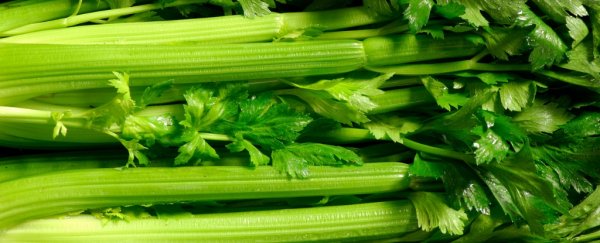There are few vegetables dieters worship more than celery. With only a handful of calories per stalk, this bright green leaf is often touted as a negative-energy snack, tougher to chew and digest than it's worth.
Except that's not actually true. A new study on lizards, available in pre-print ahead of peer review, has found little validity to this claim, refuting the existence of negative-calorie foods - like celery, lettuce, grapefruit, cucumber, and broccoli - altogether.
"Regardless of the [calories] in the food, you're always going to be able to get something out of it," senior author Stephen Secor from the University of Alabama told LiveScience.
"It's not going to be a lot; but the food itself always is going to provide a profit."
As we mentioned, the research wasn't done on humans. Instead, the authors used nine bearded dragons (Pogona vitticeps), an omnivorous lizard native to Australia. And while yes, that may sound absurd, these lizards actually digest, absorb and assimilate their food in a similar way to humans.
After fasting for ten days, the lizards were given raw diced celery. Calculating the energy lost to digestion, poop and urine, the researchers found a net profit of energy.
It seemed that the animals had used about 33 percent of the calories for digestion, and 43 percent were excreted. In the end, that means the animal retained 24 percent, nearly a quarter of the celery's total caloric energy.
"On its face value, this empirical study debunks the claim that celery is a "negative-calorie" food, and raises doubts to the proposal that such foods do exist," the authors write.
"However, it can be asked whether the cost of celery digestion and energy lost via excretion for the lizards approximates the equivalent cost and loss for humans."
To make this translation, the authors made a series of conservative estimations. First, that it would take 25 percent of a human's energy to absorb and chew celery (a percentage three times higher than most human studies suggest it really is). Second, the loss of energy in urine would be about 5 percent. And third, that 30 percent of the fibre energy would be excreted.
Under these circumstances, the authors calculated what would happen when a human ate celery, broccoli, apples, carrots, grapefruit, tomato, cucumber, watermelon, green leaf lettuce and blueberries.
In each case they found a net energy gain of roughly 64 percent. So if a human eats 100 calories of blueberries, they will end up with 64 calories to spare.
Even when the authors doubled the amount of energy loss to digestion and urine, as well as all the fibre energy excreted, they continued to get a net gain of 19 percent.
Sure, this isn't a lot of energy. A human's resting metabolism would churn through these calories pretty quickly. It would take over 12 kilograms of raw celery to maintain a 60 kilogram woman's resting metabolism for the day, which is what makes foods like celery useful for weight loss.
The take-away is simply this: eating low-calorie vegetables may still help you lose weight, there's just no evidence they require more energy to eat, digest and process than they provide.
This study is available on the pre-print server bioRxiv.
